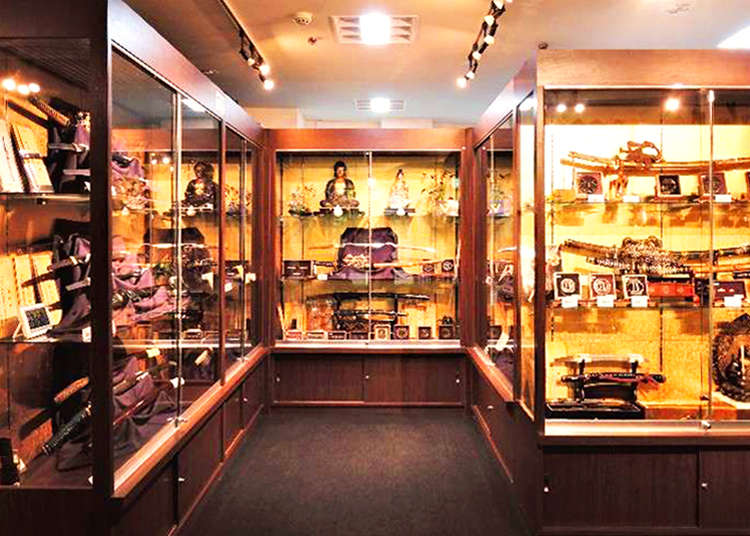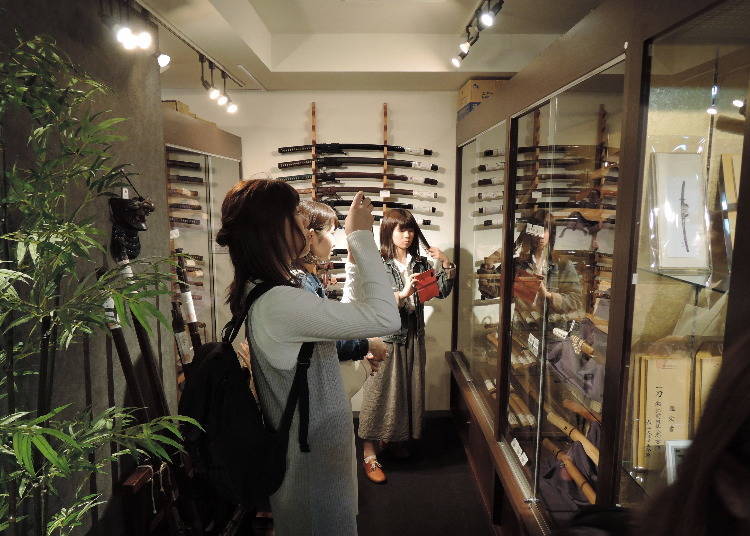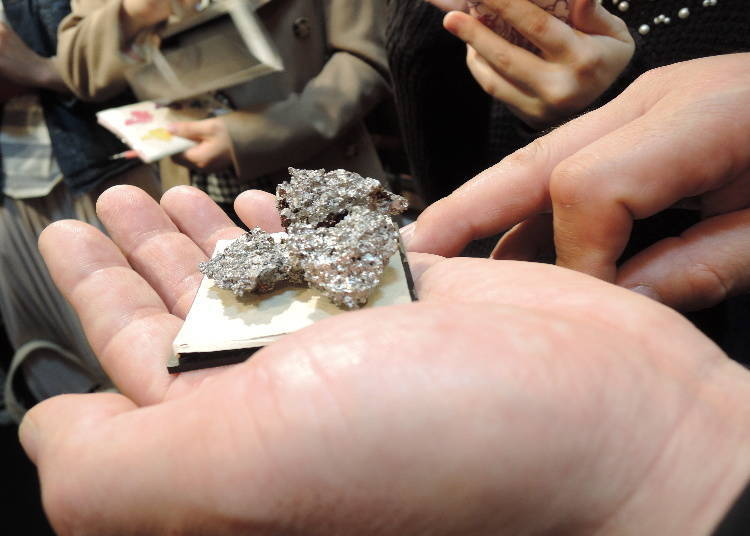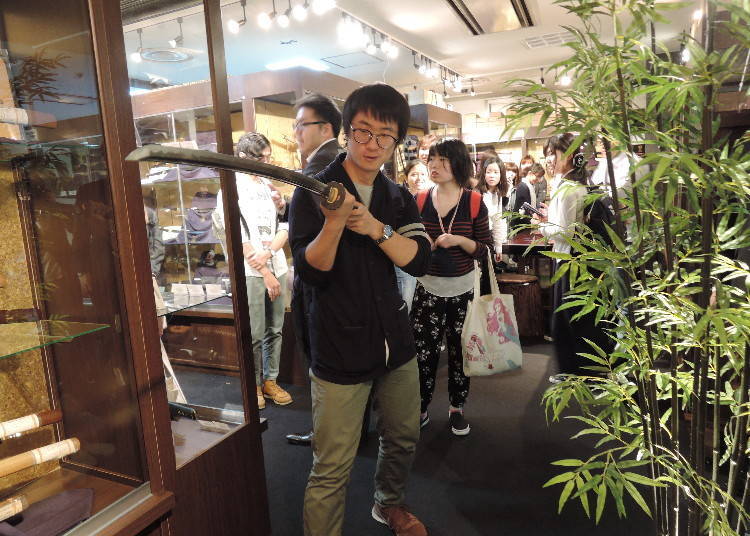
For centuries, the katana has been a revered symbol of Japanese artistry and tradition. Seiyudo in Ginza, Japan’s largest seller of antique katana swords, offers a unique opportunity to explore this iconic cultural treasure, beloved by locals and visitors alike.
LIVE JAPAN visited Seiyudo with Japanese and international college students to learn more about the famous katana.
Encountering a Real Katana for the First Time
Seiyudo in Ginza buys and sells real Japanese swords. Excitement lies in the air of the shop that is packed with about 200 unique blades and more than 200 sword guards, hilts, and all sorts of different accessories revolving around the katana – all arranged in an orderly fashion.
Looking over the many artworks, small and big, sharp and colorful, the students cannot suppress their excitement on seeing real Japanese swords up close.

“Wow... how old is this one?”
“It’s longer and heavier than I imagined.”
We spoke with the shop’s owner, Mr. Shono, an expert on the Japanese katana.
“It is said that there are hundreds of thousands of Japanese swords in existence today. Historically, generations of people have cherished these weapons, keeping them in excellent condition—some for over 800 years without a trace of rust.
"The curved shape of the Japanese sword, one of its defining characteristics, was continuously refined throughout history. Additionally, the enigmatic katana, born from fire, has long been a symbol of faith and authority. It has played a significant role in shaping the concept of the 'Japanese spirit.'
"The katana also symbolizes protection throughout a person’s life, guarding them from harm. Some Japanese swords have been preserved for over a thousand years, retaining both their form and cultural significance in modern times.”

Japanese swords are also kept as historically valuable works of art. When the students learn that there are also art swords that only the highest-ranking samurai were allowed to carry – and that those fetch prices between millions and billions of yen, they’re as shocked as they are surprised.
The Essence of the Katana, Carried on by Japanese Swordsmiths Even Today
“By the way, everyone, do you know what Japanese swords are made of?” Mr. Shono asks the students. “The main ingredient of a katana is tamahagane—steel made from iron sand,” he explains, allowing the students to touch the tamahagane steel.
“It looks like a scraggy stone!”
“It’s hard to believe that a slender Japanese katana could come from this lump.”
“The steel is hammered repeatedly while being heated, and the smithing period varies depending on the sword. On average, it takes about three months to complete.”
The swordsmiths who craft these katana are called tosho in Japanese. In the past, some were even designated as living national treasures of Japan.
However, swordsmithing has declined significantly, and today, only about 300 swordsmiths remain in the country, preserving the traditional techniques of Japanese sword-making.

Holding a Japanese Sword – and a Piece of History
Mr. Shono invites the students to try and hold a katana for themselves – a rare opportunity that is greeted with the appropriate excitement.


At Seiyudo, the students didn’t just learn about the history of Japanese katana—they also had the rare opportunity to hold them first-hand. What did they have to say about this unforgettable experience?
“People have made great efforts to protect and treasure these blades. I learned that this care and dedication are what make the katana so valuable, treasured for centuries.” (Nationality: Japan)
“I believe the value of a katana cannot be measured in money. They hold a meaning that transcends price.” (Nationality: Vietnam)
“Through this experience, I gained insight into the historical and cultural significance of the Japanese katana. They symbolize courage, loyalty, and bushido, the samurai spirit. Beyond their historical value, they are also esteemed as works of art.” (Nationality: Vietnam)
“The craftsmanship of Japanese swordsmiths is incredible. What impressed me the most is how the traditional smithing process is faithfully preserved. The katana is not just a weapon but also a work of art.” (Nationality: China)
As interest in Japanese katana has surged in recent years—particularly among young women—it’s clear that the future of the katana remains bright, even as the art of swordsmithing teeters on the brink of decline.
Seiyudo offers a truly unique experience that immerses you in this vital part of Japanese history. Touch, listen, and admire—and discover the timeless beauty of Japan’s katana.
-
 LIVE JAPAN is certified by the beyond2020 program.
LIVE JAPAN is certified by the beyond2020 program.
- Area
- Category
*Prices and options mentioned are subject to change.
*Unless stated otherwise, all prices include tax.
Popular Tours & Activitiess
Recommended places for you
-

Jujutsu Kaisen Takes Over JR East With a Wrapped Shinkansen This Winter
by: Guest Contributor
-

How to Get Don Quijote's Exclusive 2025-2026 Winter Gift (+Tax-Free Savings)
-

This Winter, Godzilla Takes Over Haneda Airport
by: Guest Contributor
-

First Japan Cherry Blossom 2026 Forecast Announced! Here's When & Where to See Sakura in Japan
-
Ad

(Opening in Jan 2026) 'THE SUMO LIVE RESTAURANT HIRAKUZA GINZA TOKYO!' 5 Exciting Ways to Experience the World of Sumo!
-

Strawberries, Style, and Tokyo’s Coolest Neighborhood: Winter Afternoon Tea in Kichijoji
by: Guest Contributor
Inspiration for Accommodations
-

Enjoy Mt. Fuji from the Comfort of Your Room! Recommended Ryokan with Mt. Fuji View
-

Stay Near the Cherry Blossoms! Hotels for Cherry Blossom Viewing in Tokyo
-

Family-Friendly Hotels with Free Shuttle to Disneyland: Convenient Access for a Magical Stay
-

Top Ranked Hakone Hotels with Mt. Fuji View: Enjoy Stunning Scenery from Your Private Space
-

Convenient Tokyo Hotels with Airport Shuttle: Ideal for Families and Heavy Luggage
-

Stunning Tokyo Tower View Hotels: Enjoy Spectacular Scenery from Your Private Space
-

Convenient Asakusa Hotels with Kitchens: Ideal for Extended Family Visits
-

Experience Luxury: Hakone's 10 Best Five-Star Accommodations
-

Enjoy Mt. Fuji Autumn Leaves! Top Hotels Near the Popular Autumn Leaves Corridor
-

Experience Hakone Fall Foliage from Your Room with Stunning Views
-

Autumn in Japan 2025: Fall Foliage Forecast & Where to Enjoy the Colorful Leaves (+Tour Info)
-

Shopping at Omotesando Harajuku: Crossroads between Culture and Fashion!
-

Meiji Shrine (Meiji Jingu): Exploring the Sacred Sanctuary of Peace in Bustling Tokyo
-

There are 30 Types of Japan Travelers, And Which One You Are Will Change Your Trip
by: Sohail Oz Ali
-

Exploring Tokyo: 4 Must-Visit Spots around Tokyo Station
-

The Samurai Restaurant: An Insane, Energetic Night of Music and Lights
by: Cassandra Lord
- #best ramen tokyo
- #what to buy in ameyoko
- #what to bring to japan
- #new years in tokyo
- #best izakaya shinjuku
- #things to do tokyo
- #japanese nail trends
- #what to do in odaiba
- #onsen tattoo friendly tokyo
- #daiso
- #best sushi ginza
- #japanese convenience store snacks
- #best yakiniku shibuya
- #japanese fashion culture
- #best japanese soft drinks



















